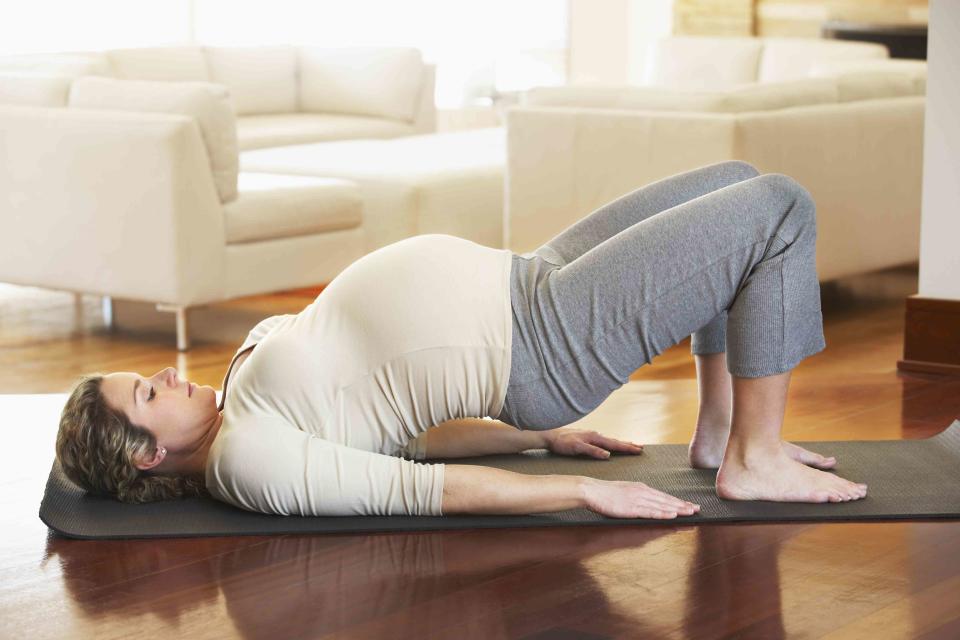Pregnancy Exercises to Strengthen Your Pelvic Floor
Strengthening your pelvic floor can lead to an easier childbirth experience and a lower risk of incontinence.

Getty Images / Ariel Skelley
Medically reviewed by Yamel Belen, R.N., IBCLC
During pregnancy, you've likely heard the term "pelvic floor" more than ever before. It refers to a group of muscles that stretch like a hammock from the pubic bone to the tailbone, and it functions to support your bladder, bowel, and uterus.
Strengthening the pelvic floor is important during pregnancy because it prepares your body for carrying and delivering a baby. Strong pelvic floor muscles also lower the risk of urinary incontinence by promoting bladder control.
Here, we rounded four pelvic floor exercises during pregnancy to try at home, from Kegels to squat combinations. Talk to your health care provider about incorporating them into your everyday routine until your little one comes—and maybe even afterwards.
Related: Should All New Birthing Parents See a Pelvic Floor Therapist?
Why Should You Do Pelvic Floor Exercises While Pregnant?
When you're pregnant, the payoffs for developing strong pelvic floor muscles are plentiful, says Julie Tupler, RN, creator of Diastasis Rehab in New York City and author of Maternal Fitness: Preparing for a Healthy Pregnancy, an Easier Labor, and a Quick Recovery.
Pregnancy strains the pelvic floor muscles due to a few factors:
Your baby's growing weight
Hormonal changes that make your muscles looser
If your pelvic floor muscle were weak already, you might develop stress incontinence, characterized by leaking when you cough, sneeze, or strain. Pelvic floor exercises can train these muscles to become stronger, so there's less risk of pregnancy and postpartum incontinence.
A weak pelvic floor can also make childbirth more difficult. Researchers have found that pelvic floor muscle training can reduce the second stage of labor (pushing), which is another benefit of exercising them while expecting.
Related: The Best Exercises to Prepare for Labor and Childbirth
Finding Your Pelvic Floor Muscles
Are you having trouble locating your pelvic floor muscles? Try this trick: Stop urinating in the middle of your stream to feel the muscles tighten up. This urination exercise isn't great for your bladder, so don't do it too often. Instead, once you recognize the feeling, simply recreate the muscle activation when you're not on the toilet.
Pelvic Floor Exercises for Pregnancy
These pregnancy pelvic floor exercises, designed by former Fit Pregnancy fitness editor Teri Hanson and based on the Tupler Technique, will teach you how to work the pelvic floor muscles. The goal: During the pushing phase of labor, you ideally relax the pelvic floor to let the baby out.
Kegels
Kegel exercises strengthen the pelvic floor muscles, helping to prevent the urinary incontinence that's common after childbirth. To do Kegels, squeeze the muscles around the vagina as if you are stopping the flow of urine; hold for 10 seconds, breathing normally, then slowly release. Do 20 reps five times a day.
Squat Combo
Holding a fixed object, such as a post or a sturdy chair, stand with your feet farther than hip-width apart. Lower your body into a deep squat, keeping your weight over your heels. (If your heels do not touch the floor, place a towel under them.) Do a Kegel then draw your abs in as you exhale. Repeat combo five times.
Belly Breathing
Belly breathing, also called diaphragmatic breathing, stretches your pelvic floor muscles. Like other pelvic floor exercises in pregnancy, it might help urinary incontinence. Sit with your legs crossed and lower back supported, hands on your belly. You can also lie down. Keeping your back and shoulders still, slowly inhale through your nose as you expand your belly. As you exhale through your mouth, draw in your abdominals, feeling them deflate.
Bridge
This exercise strengthens your pelvic floor and the glute muscles. Lie down on the floor and bend your knees at a 90-degree angle, feet flat on the ground. Push through your heels, drawing your hips into the air. Maintain this position for a few seconds before returning your buttocks to the ground. Repeat 10 times, and complete one or two more sets.
Strengthening the Pelvic Floor After Delivery
These pelvic floor exercises can also be completed after childbirth. In fact, your health care provider might recommend them for perineal healing, postpartum incontinence, and recovery from pelvic floor disorders.
Pelvic floor exercises can also treat prolapse, which involves the organs in the pelvis (like the uterus, bladder, or rectum) slipping down into the vagina.
Ask your health care provider (or your postpartum support person) for the best pelvic floor exercises for your unique situation.
For more Parents news, make sure to sign up for our newsletter!
Read the original article on Parents.

